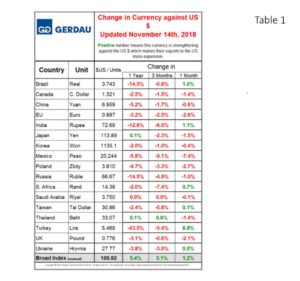Currency Report
The dollar Broad Index posted a reading of 99.78 for December, up 0.6% month on month h. On a twelve moving average, (12MMA) year on year, (y/y) comparison, the dollar was down 3.2% against the Broad Index.
 Table 1 lists the values of the U.S. dollar measured in the currency of the 17 steel trading nations that we follow as of November 14th. It reports the changes in, one year, 3 months and one month for each currency.
Table 1 lists the values of the U.S. dollar measured in the currency of the 17 steel trading nations that we follow as of November 14th. It reports the changes in, one year, 3 months and one month for each currency.
Over a three month basis, only one country gained value against the U.S. dollar. Over the last month, the five countries gained value. The Brazilian Real, Indian Rupee, Taiwan Dollar, Turkish Lira, and South African Rand each strengthened against the U.S. Dollar. Conversely the Canadian Dollar, European Euro, and Mexican Peso and others weakened against the dollar, declining 1.6%, 2.6% and 7.4% respectfully.
Referencing Reuter’s news, the increase of the British pound was caused by the growing hopes of a breakthrough, it surged in late European trading on British media reports that the withdrawal treaty text was provisionally agreed. It shot up 0.9 percent to 86.56 pence EURGBP=D3 versus the euro, its strongest level since mid-April, with more than half the gain following the reports.
At Gerdau, we keep a close eye on the currency market because it has a profound impact on both the import and export of raw materials, semi-finished and finished steel. A strengthening USD is a “double-edged sword”, as it makes the U.S. market more attractive other countries to export to the U.S. and conversely imposes strong head-winds for the U.S. to export its products to other nations.

